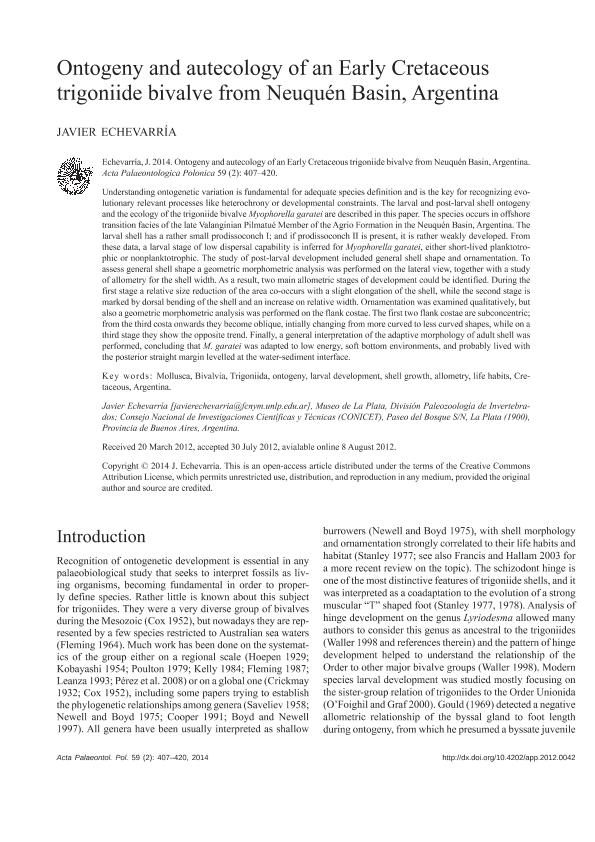Mostrar el registro sencillo del ítem
dc.contributor.author
Echevarría, Javier

dc.date.available
2017-12-22T19:06:59Z
dc.date.issued
2014-06
dc.identifier.citation
Ontogeny and autecology of an Early Cretaceous trigoniide bivalve from Neuquén Basin, Argentina; Polish Academy of Sciences. Institute of Paleobiology; Acta Palaeontologica Polonica; 59; 2; 6-2014; 407-420
dc.identifier.issn
0567-7920
dc.identifier.uri
http://hdl.handle.net/11336/31416
dc.description.abstract
Understanding ontogenetic variation is fundamental for adequate species definition and is the key for recognizing evolutionary relevant processes like heterochrony or developmental constraints. The larval and post-larval shell ontogeny and the ecology of the trigoniide bivalve Myophorella garatei are described in this paper. The species occurs in offshore transition facies of the late Valanginian Pilmatué Member of the Agrio Formation in the Neuquén Basin, Argentina. The larval shell has a rather small prodissoconch I; and if prodissoconch II is present, it is rather weakly developed. From these data, a larval stage of low dispersal capability is inferred for Myophorella garatei, either short-lived planktotrophic or nonplanktotrophic. The study of post-larval development included general shell shape and ornamentation. To assess general shell shape a geometric morphometric analysis was performed on the lateral view, together with a study of allometry for the shell width. As a result, two main allometric stages of development could be identified. During the first stage a relative size reduction of the area co-occurs with a slight elongation of the shell, while the second stage is marked by dorsal bending of the shell and an increase on relative width. Ornamentation was examined qualitatively, but also a geometric morphometric analysis was performed on the flank costae. The first two flank costae are subconcentric; from the third costa onwards they become oblique, intially changing from more curved to less curved shapes, while on a third stage they show the opposite trend. Finally, a general interpretation of the adaptive morphology of adult shell was performed, concluding that M. garatei was adapted to low energy, soft bottom environments, and probably lived with the posterior straight margin levelled at the water-sediment interface.
dc.format
application/pdf
dc.language.iso
eng
dc.publisher
Polish Academy of Sciences. Institute of Paleobiology

dc.rights
info:eu-repo/semantics/openAccess
dc.rights.uri
https://creativecommons.org/licenses/by-nc-sa/2.5/ar/
dc.subject
Bivalvia
dc.subject
Trigoniida Ontogeny
dc.subject
Larval Development
dc.subject
Shell Growth
dc.subject
Allometry
dc.subject
Life Habit
dc.subject
Cretaceous
dc.subject
Argentina
dc.subject.classification
Meteorología y Ciencias Atmosféricas

dc.subject.classification
Ciencias de la Tierra y relacionadas con el Medio Ambiente

dc.subject.classification
CIENCIAS NATURALES Y EXACTAS

dc.title
Ontogeny and autecology of an Early Cretaceous trigoniide bivalve from Neuquén Basin, Argentina
dc.type
info:eu-repo/semantics/article
dc.type
info:ar-repo/semantics/artículo
dc.type
info:eu-repo/semantics/publishedVersion
dc.date.updated
2017-12-21T19:58:26Z
dc.identifier.eissn
1732-2421
dc.journal.volume
59
dc.journal.number
2
dc.journal.pagination
407-420
dc.journal.pais
Polonia

dc.description.fil
Fil: Echevarría, Javier. Universidad Nacional de La Plata. Facultad de Ciencias Naturales y Museo. División Paleozoología Invertebrados; Argentina. Consejo Nacional de Investigaciones Científicas y Técnicas; Argentina
dc.journal.title
Acta Palaeontologica Polonica

dc.relation.alternativeid
info:eu-repo/semantics/altIdentifier/doi/http://dx.doi.org/10.4202/app.2012.0042
dc.relation.alternativeid
info:eu-repo/semantics/altIdentifier/url/http://www.app.pan.pl/article/item/app20120042.html
Archivos asociados
